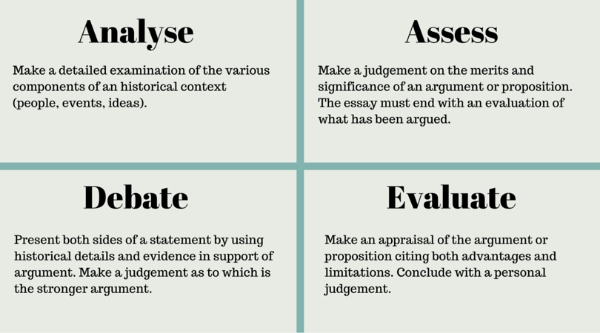Despite all the access to digital technology we have today, our students still need to be able to communicate their knowledge and understanding in writing. This means students must be able to develop coherent arguments and use evidence appropriately.
In teaching Modern History to Year 11 and 12 students I have found myself constantly re-teaching “how to…” as if for the first time! As examinations draw near, I have been asked to write a post about essay writing. So here it is!
The purpose of a history essay is to present a thesis and develop a clear line of argument. In this form of communication, students need to ensure their argument is well-supported with evidence.
Teaching Essay Writing: Step by Step
Step One: Plan
- Scrutinise the question: what ‘directional’ words are there? What do they mean? Evaluate? Examine? Curriculum Council produced a document in 2008 outlining the meaning of terminology used in Modern History Examinations. The most commonly used directional words and their meanings are outlined below:
- Write the answer in ONE sentence!
- Plan your answer in a series of dot points. Set it out the basic structure of your argument. A plan can look like this:
STEP TWO: INTRODUCTION
- First, write 3-4 sentences to set out the context of the question including important ideas, people, places, and/or events.
- Second, write the answer as a series of 3-4 sentences. This is the thesis statement. It needs to be clearly stated and outline the direction of the essay and the argument that will be pursued.
Step three: paragraphs
Paragraphs show readers or markers how the conclusion or argument was reached. A paragraph should contain the following parts:
- A topic sentence to establish the argumentative point. This needs to be written in a short, succinct sentence.
- Write a historical narrative which is supported with evidence. Where necessary, include critical comments. If appropriate to the argument, delve into historiography. That is, are there conflicting perspectives? Critically assess these to show your understanding that history is complex and complicated!
- Tie-back the argument by relating the content of the paragraph back to the question. The tie-back sentence can also be used to lead into the next paragraph.
STEP FOUR: CONCLUSION
Draw together the argument by considering the significance of the argument presented. Do this by reflecting upon the 'sum' of the argument presented. Avoid introducing new ideas, re-writing the introduction or using quotes and questions.
Download a free printable for your students!



